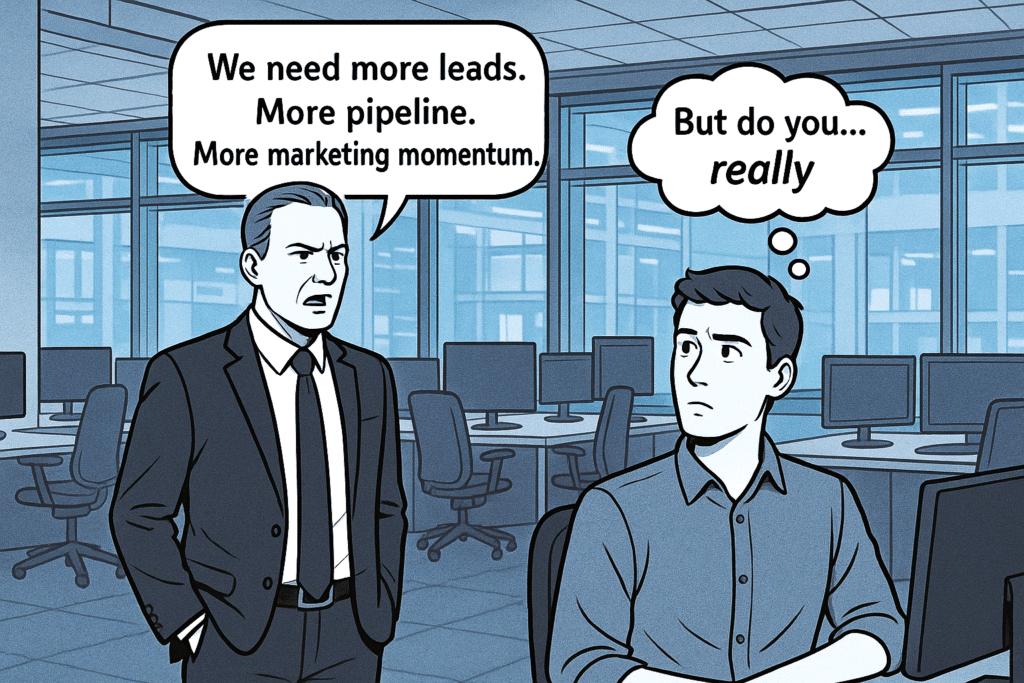Construction project management software companies face a unique set of challenges. From ensuring seamless coordination across multiple disciplines to maintaining visibility and accountability among all stakeholders, the demands on these software solutions are immense.
In this post, we explore these challenges and highlight the transformative potential of a strong marketing strategy for winning new customers.
Project management is a critical component that can make or break a project. Advanced Project Management Software (APMS) tailored for the construction industry offers a robust solution to the complex challenges faced by construction managers.
However, devising an effective marketing strategy for APMS in this niche sector requires a nuanced understanding of both the industry’s challenges and its opportunities. Equally important are Advanced Work Packaging (AWP), 3D modeling, and automation in revolutionizing construction project management.
Understanding Advanced Work Packaging
Advanced Work Packaging is a game-changer in construction project management. AWP involves breaking down a project into manageable packages that can be executed efficiently. This approach enhances coordination, improves visibility, and ensures that all stakeholders are aligned with the project goals.
Marketing AWP to Potential Customers
- Efficiency – Highlight how AWP streamlines workflows and reduces project timelines.
- Cost Savings – Demonstrate the potential for significant cost savings through better planning and reduced rework.
- Risk Mitigation – Emphasize how AWP helps identify and mitigate risks early in the project lifecycle.
The Importance of 3D Modeling
3D modeling has become indispensable in modern construction project management. It provides a comprehensive visualization of the project, enabling better planning, design accuracy, and collaboration.
- Enhanced Visualization – 3D models offer a detailed view of the project, helping stakeholders understand complex designs.
- Improved Collaboration – Facilitates better communication and coordination among project teams.
- Error Reduction – Identifies potential design conflicts and issues before construction begins, reducing costly errors.
Constraint Management Across Multiple Disciplines
Effective constraint management involves addressing limitations related to resources, time, and budget. This requires a holistic approach that considers the interdependencies between different project aspects.
- Integrated Planning – Use integrated project management tools that provide a unified view of constraints across all disciplines.
- Real-Time Monitoring – Implement systems that offer real-time updates on constraint status, enabling proactive management.
- Collaboration Platforms – Facilitate communication and coordination through collaborative platforms that bring all stakeholders together.
Automation, Visibility, and Accountability
- Complex Coordination – Managing numerous stakeholders—vendors, contractors, and subcontractors—across various phases of a project can be overwhelming. Ensuring that everyone is on the same page is crucial for project success.
- Visibility and Accountability – Maintaining transparency in project status and ensuring accountability for deliverables are critical to prevent delays and cost overruns.
- Constraint Management – Balancing resource constraints, timelines, and budget limitations across multiple disciplines and companies requires robust planning and real-time adjustments.
- Integration with Emerging Technologies – Adopting and integrating new technologies such as 3D modeling and automation tools into existing workflows can be challenging but is essential for staying competitive.
Market Challenges
Market Saturation and Competition
The construction industry is flooded with various project management tools, making it challenging to stand out. Competitors range from well-established software giants to innovative startups, all vying for the same customer base.
Complex Decision-Making Processes
Construction projects often involve multiple stakeholders, including project managers, architects, engineers, and clients. Convincing each stakeholder of the software\’s value can be a prolonged and intricate process.
Technological Resistance
The construction industry has traditionally been slow to adopt new technologies. Resistance to change and the preference for manual processes can hinder the adoption of advanced software solutions.
Customization Needs
Every construction project is unique, necessitating customizable software solutions. Demonstrating that the APMS can be tailored to meet diverse project requirements is crucial but challenging.
Integration with Existing Systems
Construction companies often use various legacy systems and tools. Ensuring seamless integration with these existing systems can be a significant hurdle.
Opportunities in the Market
Increased Demand for Efficiency
The construction industry is increasingly recognizing the need for efficient project management to meet deadlines and budgets. APMS can significantly streamline processes and enhance productivity.
Growth of Smart Construction
With the rise of smart construction technologies, there’s a growing market for integrated solutions that offer real-time data analytics, BIM integration, and IoT compatibility.
Focus on Sustainability
Sustainable construction practices are on the rise. APMS can support green building initiatives by optimizing resource management and reducing waste.
Government Initiatives and Regulations
Government mandates for digitalization and improved project management standards provide a fertile ground for marketing APMS as a compliance tool.
Remote and Hybrid Work Models
The shift towards remote and hybrid work models post-pandemic has increased the need for cloud-based project management solutions that enable collaboration from anywhere.
Global Growth Opportunities
The construction project management software market is poised for significant growth across various regions:
- North America – Driven by technological advancements and large infrastructure projects.
- LatAm – Increasing urbanization and infrastructure development are boosting demand for advanced project management solutions.
- EMEA – Growing focus on smart cities and sustainable construction practices is creating new opportunities.
- Asia Pacific – Rapid industrialization and urban development are fueling the need for sophisticated project management tools.
The Need for a Strong Marketing Strategy Before Starting Sales and Marketing
Before diving into sales and marketing activities, it\’s crucial to establish a strong marketing strategy. A well-defined strategy ensures that all efforts are aligned with clear objectives, target the right audience, and effectively communicate the unique value proposition of you Project Management Software.
Without a solid strategy, marketing and sales efforts can become disjointed, leading to wasted resources and missed opportunities. A strategic approach provides a roadmap for reaching potential customers, differentiating the product in a competitive market, and ultimately driving adoption and growth.
The Right Approach to Marketing
Clarity and Direction
A well-defined marketing strategy provides a clear roadmap for all marketing and sales activities. It outlines objectives, identifies target audiences, and sets measurable goals, ensuring that all efforts are focused and aligned. This clarity prevents wasted resources and ensures that every action contributes towards the overall goals.
Understanding the Market
Conducting thorough market research as part of the strategy helps in understanding the market landscape, including competitors, customer needs, and industry trends. This knowledge is vital for positioning the APMS effectively and highlighting its unique value proposition.
Identify Target Audience
Segment the market to identify key stakeholders such as construction managers, IT directors, and C-suite executives. Tailor marketing messages to address the specific pain points and needs of each group.
Value Proposition and Differentiation
Clearly articulate the unique features and benefits of the APMS. Highlight aspects like real-time collaboration, advanced analytics, ease of integration, and customization capabilities.
Content Marketing and Thought Leadership
Develop a robust content marketing strategy that includes blogs, whitepapers, case studies, and webinars. Position the company as a thought leader in construction project management by sharing insights, trends, and best practices.
Targeted Messaging
A strong marketing strategy helps in crafting targeted messages that resonate with specific segments of the market. Tailoring communications to address the unique pain points and needs of different stakeholders enhances the relevance and impact of marketing efforts.
Customer Testimonials and Case Studies
Showcase success stories and testimonials from satisfied customers. Real-world examples of how the software has improved project outcomes can be highly persuasive.
Leverage Industry Partnerships
Form strategic alliances with construction firms, industry associations, and technology partners. Co-host events and webinars to reach a broader audience and build credibility.
Targeted Digital Marketing
Utilize SEO, PPC, and social media marketing to reach potential customers. Invest in targeted ads on platforms frequented by construction professionals, such as LinkedIn and industry-specific forums.
Resource Allocation
With a strategic approach, resources such as time, budget, and personnel can be allocated more efficiently. Prioritizing high-impact activities and channels ensures that investments yield the best possible returns.
The Need for a Marketing Strategy
A well-devised marketing strategy is essential for penetrating the competitive market of construction project management software. It ensures that the unique selling points of their system are effectively communicated to the right audience, overcoming adoption barriers and driving growth.
By addressing the specific challenges of the construction industry and capitalizing on emerging opportunities, a strategic approach can position the software as a must-have tool for modern construction management.
Conclusion
Devising a marketing strategy for Project Management Software in the construction industry involves navigating significant challenges while leveraging unique market opportunities. By understanding the industry’s specific needs and adopting a targeted value-driven approach, businesses can successfully introduce their solutions to a market eager for innovation and efficiency.
As the demand for efficient and effective project management solutions grows globally, the opportunities for innovation and expansion are vast. Remember, a comprehensive marketing strategy not only enhances visibility and credibility but also drives adoption and growth in a competitive landscape.



